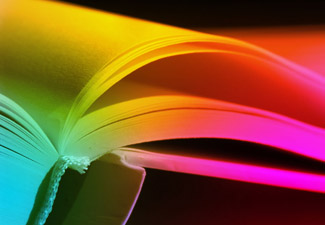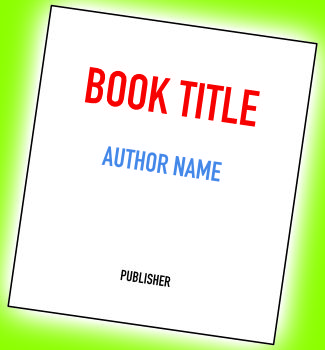 Learn how to make a simple book signature (group of pages) by hand and have some fun at the same time. Once you try this, you’ll understand how book signatures are put together. And you’ll quickly see how a stack of signatures can become a complete book. [Read more…]
Learn how to make a simple book signature (group of pages) by hand and have some fun at the same time. Once you try this, you’ll understand how book signatures are put together. And you’ll quickly see how a stack of signatures can become a complete book. [Read more…]
Book Design
 Below you'll find links to all the information about book design that’s available on our website, book, videos, and blog.
Below you'll find links to all the information about book design that’s available on our website, book, videos, and blog.
Get started with Part I of Book Design Made Simple, where you’ll learn how to lease and install Adobe InDesign, create a document, and import your manuscript from Word. Download Part I for free by subscribing to our blog—simply use the form below.
Excerpts from Book Design Made Simple
- Basic principles of good design: what are they?
- Front matter — what to include in the front of your book
- Back matter — what to include in the back of your book
- Running heads — what to include in your novel or nonfiction book
- Typeface vs font: what’s the difference?
- Book trim size: how to choose the right trim size
- Book binding: many options beyond softcover and hardcover
Video tutorials
Blog posts
Below are all the blog posts in the Book Design category, starting with the most recent post.
Special signature inserts in books
 Have you ever wondered why some books gather all of their photos and other images together into a few pages in the middle? These groups of pages are called special signature inserts. We’ll explain why this is practical in traditional printing on paper, and why there are also reasons to do it even with print-on-demand. Plus we’ll show you how to set up your own book this way.
Have you ever wondered why some books gather all of their photos and other images together into a few pages in the middle? These groups of pages are called special signature inserts. We’ll explain why this is practical in traditional printing on paper, and why there are also reasons to do it even with print-on-demand. Plus we’ll show you how to set up your own book this way.
Designing a book title page
 Every book needs a title page. Whether it’s in a printed book or an ebook, the title page shows the official title, author, and publisher that will go into the Library of Congress database—or the equivalent database in your country.
Every book needs a title page. Whether it’s in a printed book or an ebook, the title page shows the official title, author, and publisher that will go into the Library of Congress database—or the equivalent database in your country.
Also, it’s supposed to be the first, or almost the first, page that a reader sees. As such, it has the potential to set the tone for the rest of the book, and with a good design, add marketing value.
So here are some ideas, starting with the basics. [Read more…]
Book edge treatments

Fore edge painting: JoyfullyTessaStudios
Book edge treatments include anything that is applied to the edges of a book’s pages. This includes paint or gilding, or even patterns cut into the paper. Some treatments are done during a book’s production at the printer or bindery, and others are applied manually after a book is printed and bound.
We’ve compiled some ideas to inspire you about creative and fun ways to jazz up your books. [Read more…]
Creative book cover treatments
 Does your printed masterpiece deserve a special creative book cover treatment? Maybe some silver or gold, or the book title sticking up? How about the title pressed below the surface of the cover? Or some parts of the cover design being shinier than other parts?
Does your printed masterpiece deserve a special creative book cover treatment? Maybe some silver or gold, or the book title sticking up? How about the title pressed below the surface of the cover? Or some parts of the cover design being shinier than other parts?
We’ll explain how the printer produces all of these creative book cover treatments, and more, for hard (casebound) covers, book jackets, and paperbacks. We’ll also mention how you could actually fake some of these effects yourself. [Read more…]
Designing book running heads
 What are running heads, anyway? And running feet? And should you care about how they are designed? Yes!
What are running heads, anyway? And running feet? And should you care about how they are designed? Yes!
You might know a running head as a “header,” and a running foot as a “footer.” In fiction books, the running heads announce the author and book title on each spread. In nonfiction and anthologies, they help readers find their way around. [Read more…]
Book endpapers: A gallery of ideas
 Book endpapers (also called endsheets) are probably the least noticed part of a hardcover book. But the endpapers are literally what hold the pages and the cover together. And they can add value to your book if you use them well.
Book endpapers (also called endsheets) are probably the least noticed part of a hardcover book. But the endpapers are literally what hold the pages and the cover together. And they can add value to your book if you use them well.
If you’re publishing a paperback, take a look at the examples in this article for ideas anyway; you’ll find that the same principles can apply. [Read more…]
Designing a book spine
 Front covers attract and back covers sell—we’ve said it before. At the same time, a book spine should broadcast.
Front covers attract and back covers sell—we’ve said it before. At the same time, a book spine should broadcast.
Most books in stores and libraries are shelved with their spines facing out. If a book has a great title and a well-designed spine, it’ll attract a lot more eyes than its neighbor on the shelf. So here’s how to accomplish that for your book. [Read more…]
What type size should I use?
 In Book Design Made Simple, we suggest type sizes that should work in most situations for adult readers. But there are so many other situations! What about children’s books? What about large type books? Reference books? In this article we’ll suggest solutions for these kinds of books. And we’ll only discuss printed books; with ebooks, the reader can enlarge or reduce the type size to whatever works for them. [Read more…]
In Book Design Made Simple, we suggest type sizes that should work in most situations for adult readers. But there are so many other situations! What about children’s books? What about large type books? Reference books? In this article we’ll suggest solutions for these kinds of books. And we’ll only discuss printed books; with ebooks, the reader can enlarge or reduce the type size to whatever works for them. [Read more…]
Design a workbook
 Want to design a workbook? Who uses those any more?
Want to design a workbook? Who uses those any more?
Lots of folks, actually. Even though there are apps for practically everything these days, children still enjoy workbooks for mazes or drawing or learning practically anything. Adults can use them for recording their latest bird find or geocaching location, or for word or number puzzles, for instance. A coloring book can be considered a workbook, too.
We’ll help you design a workbook that will work well for your audience.
- 1
- 2
- 3
- 4
- Next Page »

